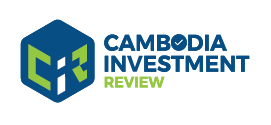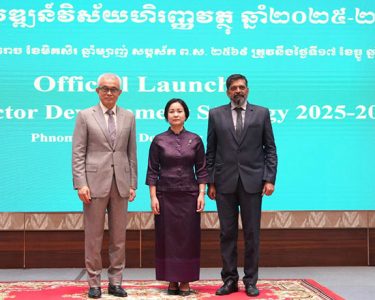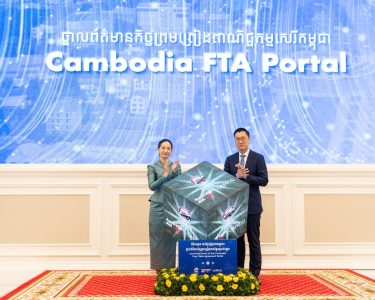Cambodia Investment Review
Cambodia’s economy is projected to grow by 5.2% in 2025—down from earlier forecasts of 6.0%—as escalating U.S. tariffs and global trade uncertainties weigh on the ASEAN+3 region, according to the ASEAN+3 Macroeconomic Research Office (AMRO)’s July 2025 update. The revision reflects broader economic headwinds affecting trade-dependent economies like Cambodia, which is also navigating softer tourism recovery and investment slowdowns.
The AMRO report, available here, provides a quarterly update on the regional outlook, emphasizing rising protectionism, monetary easing, and the need for deeper regional cooperation.
Read More: AMRO Report Highlights Cambodia’s Growing Role in ASEAN’s Digital Payment Connectivity
Trade Pressures Prompt Regional Downgrades
The ASEAN+3 region—which includes the 10 ASEAN nations along with China, Japan, and South Korea—is forecast to expand by 3.8% in 2025 and 3.6% in 2026, both downward revisions from earlier expectations. The report cites a broad-based slowdown in global demand, exacerbated by U.S. tariffs that are set to take effect on August 1. For Cambodia, these tariffs are contributing to lower export competitiveness and heightened investor uncertainty.
AMRO warns that under an adverse scenario—where tariffs are hiked further or extended to key sectors such as semiconductors and pharmaceuticals—regional growth could dip below 3%, marking its lowest level since the Asian Financial Crisis (excluding COVID years).
“Cambodia, like many regional peers, is highly vulnerable to external shocks,” AMRO noted, adding that its relatively open economy and export orientation make it especially sensitive to disruptions in global trade.

Domestic Demand Offers Some Resilience
Despite external pressures, Cambodia’s domestic demand has remained steady. Private consumption continues to benefit from stable labor markets and moderating inflation, with inflation projected at 2.5% in 2025, down from 2.9% in 2024. The stable price environment, according to AMRO, gives policymakers room to maintain supportive fiscal and monetary policies.
Other ASEAN economies, including the Philippines and Indonesia, have already begun cutting interest rates in response to the evolving macroeconomic landscape. Cambodia’s central bank has yet to follow suit but may consider easing if downside risks intensify.
The region’s export performance received a short-term boost in early 2025 due to frontloaded orders in anticipation of tariff hikes. However, as those shipments fade, the outlook for the remainder of the year is more muted, particularly for service exports like tourism, where Cambodia is still recovering from a slowdown in Chinese and European arrivals.

Risks Multiply as Geopolitical Tensions Rise
Among the five key risks highlighted in the AMRO report are:
- U.S. Protectionist Measures: Additional tariffs on ASEAN+3 exports could further weaken trade performance. The U.S. administration is also weighing tariffs on currently exempt items like semiconductors—a sector that indirectly impacts Cambodia’s growing electronics assembly base.
- China’s Sluggish Property Sector: Weaker demand from China could reduce inbound investment and tourist arrivals to Cambodia, given the historical strength of bilateral economic ties.
- Middle East Geopolitics: Any disruption to oil shipments through the Strait of Hormuz, such as from renewed Iran-Israel conflict, would hit Cambodia particularly hard. The Kingdom relies heavily on Middle Eastern energy imports, as detailed in AMRO’s scenario modeling.
- Financial Market Volatility: Currency depreciation and higher interest rates abroad may trigger capital outflows from emerging markets, including Cambodia.
- Climate and Demographic Challenges: AMRO also warns of long-term structural risks such as climate change and aging populations, though the former is more pressing for Cambodia given its rural demographic and agriculture-heavy economy.

Regional Response and Policy Options
Several ASEAN+3 economies have begun easing monetary policy and introducing fiscal stimulus to soften the blow of trade shocks. In parallel, AMRO notes efforts to deepen regional integration—such as strengthening supply chain resilience and pushing intra-regional trade—as critical for long-term recovery.
For Cambodia, such measures may include accelerating the implementation of the Regional Comprehensive Economic Partnership (RCEP), and working with regional partners like Australia through CAPRED, which continues to support infrastructure and economic resilience projects.
As Cambodia’s Ministry of Economy and Finance and National Bank of Cambodia consider their next steps, AMRO’s report underscores the importance of adaptability in the face of geopolitical and structural change.
“Resilience will hinge not only on macroeconomic stability but also on the ability to pivot toward more diversified and sustainable sources of growth,” the report concludes.

For further analysis, access the full ASEAN+3 Regional Economic Outlook (AREO) July 2025 report.





